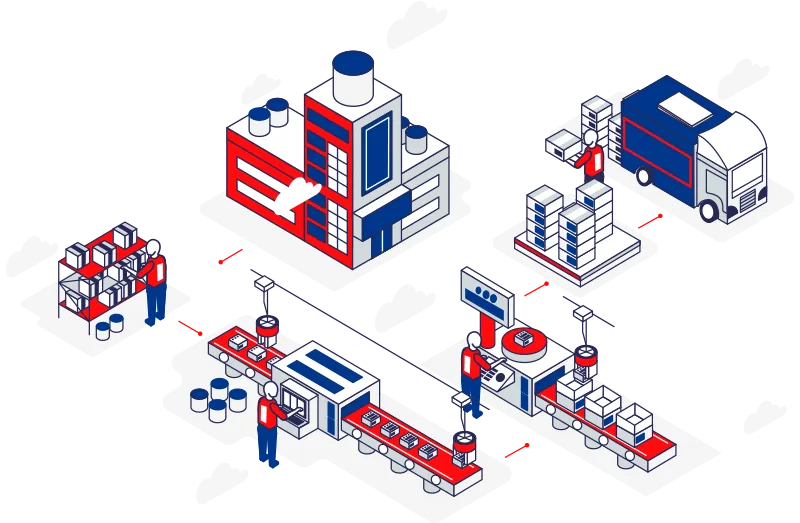Manufacturing Execution System


For efficient production control and visibility, the Fabrix Manufacturing Execution System (FabrixMES) streamlines operations, improves quality and enhances profitability. It ensures compliance with closed-loop quality control and real-time monitoring, capturing error-free data on Man, Machine, and Material from machines and AIDC equipment.
FabrixMES provides actionable insights for seamless shopfloor operations, connecting, monitoring, and controlling manufacturing data flow across the plant. Positioned between ERP and process control systems, it offers real-time visibility and flexibility, integrating multiple sites and automation equipment to boost operational efficiency.
Key benefits of an MES include
- Increased customer satisfaction
- Better regulation compliance
- Improved visibility of supply chain
- Decreased manufacturing cycle time
- Reduced-order lead time
- Reduced labor costs
- Increased equipment efficiency

Our clients credit us for our breakthrough technology in the automation industry.
I would recommend Inventrax to any Manufacturing company, because their PCS system has been consistently reliable with our critical production lines and high valued inventory. It has improved our productivity across the entire operations.
Industries We Serve
Aviation & Defence
Amongst all domains of the discrete manufacturing industry, Aviation & Defence proves to be the most complex. Stringent compliances, severe quality control, rigid competition, wider supply chains, increasing regulations, dearth of skilled labor are a few factors that explain the complexity. While players in this industry aim at reducing costs and increasing qualitative productivity, many projects roll over the pre-fixed time and cost frames resulting in delayed deadlines as well as exceeding budgets. An efficient execution of the manufacturing process is the need of the hour to wade through such adverse situations and stay active in the business. And this could be achieved only through a competent MES Software. A well-executed MES System not only helps businesses in stopping unnecessary financial leakages but also increases productivity. Trace and Trace for Non-Confirmance returned material is much need by the MES for identifying any component, or workstation failure issues to recall the entire batch and clear the issues.Electrical & Electronics Assembly
Manufacturers of the electrical and electronics segment constantly face the need to produce mass quantities at the lowest cost while not compromising quality. Other challenging factors include steep price falls, swift technological drifts, and increasing demand for custom-made products. All such aspects force businesses of this industry to launch high end innovative products at frequent intervals to keep pace with the competition. This scenario demands a continuous, effective, and swift assembly at the shop floor level. Larger batch sizes of components need to be assembled at rapid speeds to generate high-quality products in large quantities. To get the processes rolling at such desired levels businesses need to update to cutting-edge technologies likeMES Software
which would help their processes roll over at high and effective speeds. We help you achieve such business goals in a cost-effective way. Our MES – the FalconSFT, effectively manages the material and data flow across operations. Your business would gain real-time visibility into the shop floor eliminating wastages and ensuring efficient assemblies. Get a hawk eye on your overall production with our Dashboards, and KPI’s reporting. Gain a competitive edge in your industry by choosing the rightMES Software
for your business – the FalconSFT.Automobile
The automobile industry since its inception, has been challenging. The need to introduce innovative models faster than ever, focusing on key features like safety, quality, fuel efficiency and also being eco-friendly at the same time, has mounted more pressure on the industry and its players than ever. Demanding equal attention on par with the product attributes are areas of logistics and supply chains. With businesses majorly focusing on the product, supply chain, and logistics they tend to limp concentrating on elements with equal importance such as inventory status, scrap elimination, and fluctuating component costs. An effectiveMES System
like Inventrax’s FalconSFT is needed to manage such gigantic manufacturing tasks effectively and efficiently. As businesses strive to live up to the existing market demand, FalconSFT helps businesses cut down production costs and helps produce better products faster. Businesses could also benefit through improvised processes, better management of inventories, and improved operational efficacy to name a few.Pharma & Surgical
As one of the most regulated domains of the life sciences industry, the Pharmaceutical & Surgical instruments segment has to adhere to strict standards and even more stringent quality checks. With lifestyle drugs on the rise, pharmaceutical companies need to bid goodbye to their traditional R&D cycles (which were both extensive & expensive) to introduce newer products at a faster pace to meet the competition and gain profitability. Other concerns include drug & patent expirations, counterfeiting products, etc… The surgical industry as well, is experiencing a shift in its product line with the advent of robotic surgeries gaining momentum around the globe. Businesses involved in this industry are extremely pressurized balancing the – R&D time on newer robotic surgical products, and the need to reduce the time-to-market of such products. In such highly volatile market conditions, companies in the Pharma & Surgical industry need effective solutions to survive the competition and stay active in business. An adept tool to achieve this is an effectiveMES Software
. FalconSFT, Inventrax’s innovative MES Software helps you in adapting the swift market fluctuations, respond accordingly, and ensure faster ‘product reaches’ to the market before your competition. Our MES System ensures that the items are built according to the product specification and quality. Error-free auto data capture is feasible through barcode, RFID, and SCADA systems. Effective tracking of all the shop floor activities reduces cycle times.Key Benefits of Our Solution
Inventrax products effectively address the track and traceability needs of industry by closing the information gaps that exist in disparate ERP's.

Floor Activities Visibility
Effective management and real-time visibility of shop floor activities

Resource Optimization
Increase yield along with product quality

Improved Efficiency
Improve operator and machinery efficiencies

Efficient Heterodoxy
Efficient Non-Conformance Management

Data Management
Electronically captures and tracks detailed engineering and operational data

Resources Availability Tracking
Eliminate wastages throughout production, checks for – machine, material, worker, tool availability

Data Accuracy
Rapid, accurate data collection enables error free data collection and access to real-time business intelligence across all areas of production

Accessible in Multiple Systems
Error free auto data capture through barcode , RFID and SCADA systems

Accurate KPI's
Bird’s eye view of overall production with Dashboards, KPI reporting

Data Analytics
Provides historical data analysis and reporting for product and process improvements

Paperless Management
Paperless shop floor and material dispatch management
